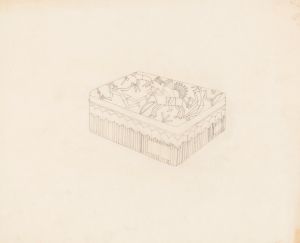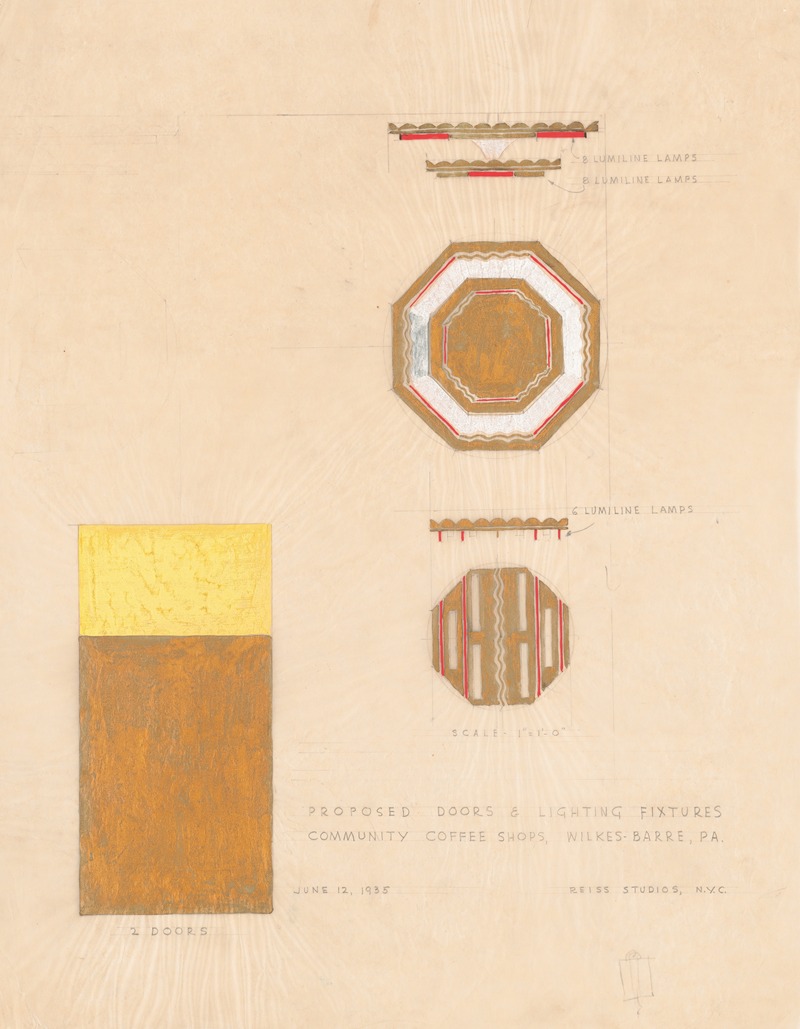
Design drawings for Community Coffee Shops, Wilkes-Barre, PA.] [Proposed doors and lighting fixtures, Lumiline light fixture and door, elevations and plan
A hand-painted replica of Winold Reiss’s masterpiece Design drawings for Community Coffee Shops, Wilkes-Barre, PA.] [Proposed doors and lighting fixtures, Lumiline light fixture and door, elevations and plan, meticulously crafted by professional artists to capture the true essence of the original. Each piece is created with museum-quality canvas and rare mineral pigments, carefully painted by experienced artists with delicate brushstrokes and rich, layered colors to perfectly recreate the texture of the original artwork. Unlike machine-printed reproductions, this hand-painted version brings the painting to life, infused with the artist’s emotions and skill in every stroke. Whether for personal collection or home decoration, it instantly elevates the artistic atmosphere of any space.
Winold Reiss was a German-American artist and designer known for his work in various artistic fields, including portraiture, graphic design, and interior design. Born in 1886 in Karlsruhe, Germany, Reiss immigrated to the United States in 1913, where he became a prominent figure in the American art scene. His work often incorporated elements of modernism and was influenced by his European training and exposure to diverse cultures.
The design drawings for Community Coffee Shops in Wilkes-Barre, Pennsylvania, attributed to Winold Reiss, reflect his expertise in interior design and architectural elements. These drawings include proposed doors and lighting fixtures, specifically featuring a Lumiline light fixture and door, along with elevations and plans. Reiss's approach to design was characterized by a keen attention to detail and a harmonious blend of functionality and aesthetics.
Reiss's involvement in the design of commercial spaces, such as coffee shops, was part of a broader trend during the early to mid-20th century, where artists and designers were increasingly engaged in creating environments that were both visually appealing and conducive to social interaction. His work in this area often involved the use of bold colors, geometric patterns, and innovative lighting solutions, which were intended to enhance the ambiance of the space and attract patrons.
The Lumiline light fixture mentioned in the design drawings is indicative of Reiss's interest in modern lighting technology. Lumiline lamps, introduced in the 1930s, were known for their tubular shape and even light distribution, making them a popular choice for both residential and commercial interiors. Reiss's incorporation of such fixtures into his designs demonstrates his commitment to integrating contemporary advancements into his work.
Reiss's designs for the Community Coffee Shops would have likely included detailed plans for the layout and decoration of the interior space, emphasizing the importance of creating a welcoming and comfortable environment for customers. His use of elevations and plans in the design process ensured that every aspect of the space was carefully considered, from the placement of furniture to the selection of materials and finishes.
Throughout his career, Winold Reiss was celebrated for his ability to merge artistic creativity with practical design solutions. His work in Wilkes-Barre, PA, as exemplified by these design drawings, is a testament to his skill and vision as a designer. While specific details about the execution and impact of these particular designs may not be extensively documented, Reiss's broader influence on American design and his contributions to the field remain significant.
Overall, Winold Reiss's design drawings for the Community Coffee Shops in Wilkes-Barre represent a fascinating intersection of art, design, and commerce, reflecting the dynamic cultural and technological changes of the time. His legacy continues to be appreciated by those interested in the history of design and the development of modern commercial spaces.





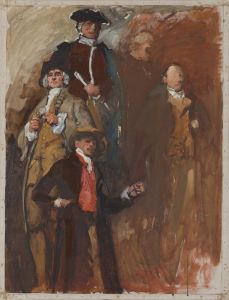

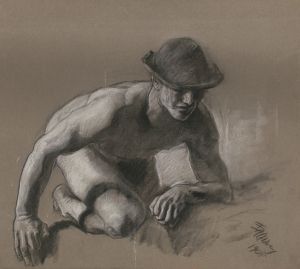
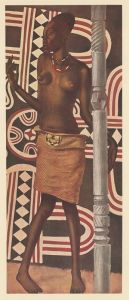
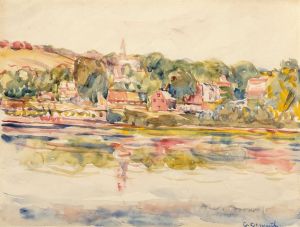
![Designs for Indian Room, Chic-n-Coop Restaurant, Montreal, Canada.] [Placemat design with chicken character wearing crown](/imgs/249244/s/winold-reiss-designs-for-indian-room-chicncoop-restaurant-montreal-canada-placemat-design-with-chicken-character-wearing-crown-67b965b8.jpg)
![Posters for Charity Bazar [i.e. Bazaar] for the widows and orphans of German, Austrian, Hungarian and their allied soldiers, March 23rd, 1916, New York, NY](/imgs/249259/s/winold-reiss-posters-for-charity-bazar-ie-bazaar-for-the-widows-and-orphans-of-german-austrian-hungarian-and-their-allied-soldiers-march-23rd-1916-new-york-ny-35f5cec1.jpg)
![[Designs for roadhouse or terrace restaurant.] [Scheme [B] with a T-plan, 5- bays, with painted tulips in the pediments.](/imgs/249264/s/winold-reiss-designs-for-roadhouse-or-terrace-restaurant-scheme-b-with-a-tplan-5-bays-with-painted-tulips-in-the-pediments-ad771334.jpg)
![[Graphic designs for Fortune magazine.] [Studies for cover drawn on black paper](/imgs/249266/s/winold-reiss-graphic-designs-for-fortune-magazine-studies-for-cover-drawn-on-black-paper-d9c315c5.jpg)
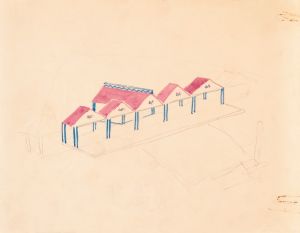
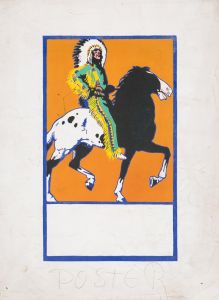

![Design for reflected ceiling plan.] [Partially colored drawing for ceiling plan](/imgs/249463/s/winold-reiss-design-for-reflected-ceiling-plan-partially-colored-drawing-for-ceiling-plan-11749db9.jpg)
